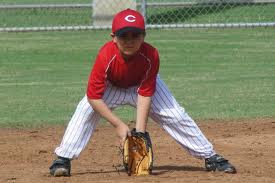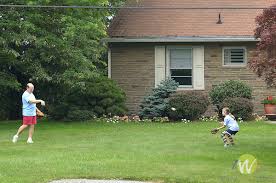“Get in front of the ball! IN FRONT of the ball!” Dreaded words from my little league coach, words sometimes yelled across the infield for encouragement, other times yelled as he towered over me, red-faced, hands on hips.
 I loved playing baseball. I loved being on the team, practicing, throwing and catching, I loved the feel of my glove, swinging the bat, chasing down fly balls. Playing catch with my older brother was the best. I loved it all except for ground balls. My fear of ground balls kept me from being more than a “pretty good” ballplayer.
I loved playing baseball. I loved being on the team, practicing, throwing and catching, I loved the feel of my glove, swinging the bat, chasing down fly balls. Playing catch with my older brother was the best. I loved it all except for ground balls. My fear of ground balls kept me from being more than a “pretty good” ballplayer.
While crouched in my position near first base, looking ready and eager, smacking my glove with my bare hand, chanting “Hey batter, batter,” I was saying to myself, “Don’t hit it to me, don’t hit it to me.” A hard grounder hit my way could hit a pebble or a dirt clod, take a bad hop, and smack me painfully on the shin or the shoulder or the forehead. I was a scrawny kid. I had no natural padding. A ball making hard contact with any part of me was a cause for lots of rubbing, sucking air through gritted teeth, then exhaling with “Ow, ow, ow.” I was not one to suffer in silence.
My biggest fear was of taking one in the teeth. With that dreaded possibility in mind, I adopted a moderately effective defensive strategy. The split second before the ball got to my glove, I’d close my eyes and turn my head to the side. With this and pretty good reflexes, I managed to catch most of the balls that came my way, but it didn’t take a trained eye to recognize my basic weakness as a fielder.
The fear of getting plunked also caused me to step away from home plate rather than toward the pitcher when batting. This was called “stepping in the bucket.” The phrase itself suggests the ineffectiveness of the motion. Even with that I managed a respectable batting average. But grounders, those were the main problem.
Fly balls weren’t much problem for me. I could judge distance and track down a fly and catch it on a dead run most of the time. I didn’t fear fly balls. They rarely take a bad bounce in the air. So once the coach found a first baseman willing to catch a short hop without turning his head, I was relegated to the outfield.
There are a few simple principles in fielding a ground ball that every little leaguer learns early. Every professional continues to practice these through an entire career.
 I’ve mentioned the first, “Get in front of the ball.” You can’t catch the ball at a distance. You must move toward it and get in front of it. “Charge the ball. You play the ball, don’t let the ball play you.” Those were coach’s words. I learned on those dusty fields that I am more likely to catch it or at least knock it down if I am directly in front of it and had my glove and whole body as a tool for stopping it.
I’ve mentioned the first, “Get in front of the ball.” You can’t catch the ball at a distance. You must move toward it and get in front of it. “Charge the ball. You play the ball, don’t let the ball play you.” Those were coach’s words. I learned on those dusty fields that I am more likely to catch it or at least knock it down if I am directly in front of it and had my glove and whole body as a tool for stopping it.
“Keep your eye on the ball.” In order to determine where and when it will bounce, how fast it’s coming, and if it has a spin on it, I must watch it closely. “Watch it all the way into your glove.” I knew that if I took my eye and my concentration off the ball, the outfielder would have a play and I’d have an error.
“Keep your glove down.” A fielder can’t bend at the waist and casually catch a ground ball. I learned to crouch, to get my glove and the rest of my body into the action. With my glove down, the ball can’t scoot under it. I could bring my glove up to catch it more quickly and accurately than I could shove it down and stab at the ball. If the ball got through between my legs, it was an error of not having my glove down on the ground, and everyone knew it.
“Stay with it.” If the ball came my way, it was my responsibility until I fielded it, made the throw, and the play was over. If I bobbled the ball, if the ball bounced out of my glove or off my shin, I was to go after it. The play was mine unless it got out of my reach and someone else fielded it.
If good fielding were simply a matter of knowing the principles, I would have been a good fielder. However, there are two other basic components to fielding well: attitude and practice.
A certain kind of attitude or mind set is required for being a good fielder. Without that mind set, skill and reflex will take you only so far. “Don’t hit it to me” is NOT the proper attitude.
My brother, Jim, had the right attitude. He wasn’t any more skilled than I was, but he was tenacious. He would do whatever was needed to keep a ground ball from getting by him. If one did, whether of the opponent’s bat in a game or off the coach’s bat in practice, he would silently dare the batter, “You’re not going to get another one by me. Just try.” Rarely did the next one get by him.
My brother and I talked a few years ago about our little league careers. He told me that much of his tenacity was based on fear. Unlike my fear of getting hurt, his fear was of not keeping his position on the team, not getting to play. His fear energized him and made him a better player. Mine made me tentative.
Then there’s practice. One Hall of Fame third baseman used to field 100 ground balls during warm ups before every game. That’s 16,500 ground balls each season. And that wasn’t during team practice. That was just to warm up and get limber before games.
Taking infield practice is a lot like practicing anything else. It is repetition for the sake of consistency. Each grounder is unique. Each requires something different from the fielder. One major league third baseman practiced fielding grounders by strapping a ping-pong paddle to each hand. To trap a moving round ball between two flat surfaces developed keen attention, coordination, and gentle but firm hands. Practice welds together attention, skill, and reflex so that adjustments to each unique play can be made quickly and without conscious thought. Simple skills come together into a complex set of skills until fielding a ground ball becomes one seamless event.
I find that I still field ground balls tentatively these days. Not hard white spheres bouncing across the grass in my direction. I’m fielding grounders of a different sort. They come in the form of decisions in my work, confrontations with my colleagues and my family, demands from clients in pain, and from my own internal coach with his hands on his hips. Yet, I find that the same principles to fielding a ground ball in little league are useful in these daily situations. Get in front of it, keep your eye on it, get your glove down, stay with it. When I procrastinate on a task, avoid a needed confrontation, give a half-hearted effort in hopes that someone else will take over, I am closing my eyes and turning my head on a short hop. It’s an exhausting and ineffective way to play the game.
 When I played catch with my daughter and my son during their t-ball, softball, and little league years, even with my little league days 40 years behind me, I made a conscious effort to field ground balls and errant throws the way my coaches tried to teach me. Though my heart would race as the ball scooted across the grass toward me, I silently said to myself, “Get in front of it, John.” It was hard to do. I still imagined I’d take one in the teeth. If it were coming too fast I’d give myself permission to resort to my old defensive technique. But I decided it’s never too late to learn to field a grounder, regardless of what kind of grounder it is.
When I played catch with my daughter and my son during their t-ball, softball, and little league years, even with my little league days 40 years behind me, I made a conscious effort to field ground balls and errant throws the way my coaches tried to teach me. Though my heart would race as the ball scooted across the grass toward me, I silently said to myself, “Get in front of it, John.” It was hard to do. I still imagined I’d take one in the teeth. If it were coming too fast I’d give myself permission to resort to my old defensive technique. But I decided it’s never too late to learn to field a grounder, regardless of what kind of grounder it is.
0 Comments until now
Add your Comment!